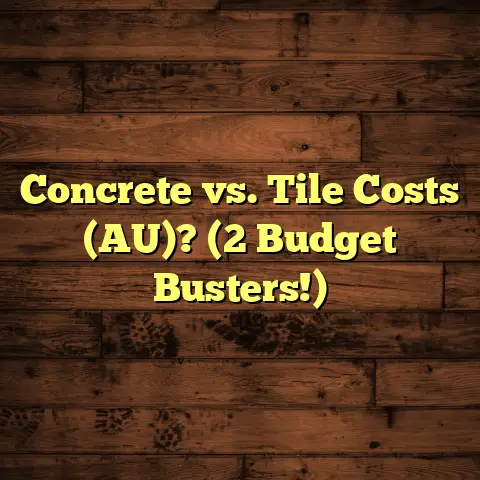What Cleans Tile Floors Best? (6 Pro Solutions!)
From the gleaming porcelain in a modern condo to the rustic terracotta in a farmhouse kitchen, I know that keeping these surfaces clean can be a real challenge.
Let’s dive into the best ways to clean your tile floors, considering your region and lifestyle.
Introduction: Regional Needs Overview
Tile floor cleaning isn’t a one-size-fits-all deal. What works wonders in Arizona might be a disaster in Florida.
Think about it: the dry, dusty air of the Southwest versus the humid, salty air of the coast – huge difference!
- Climate: Humid regions breed mold and mildew like crazy, while dry areas struggle with dust and mineral buildup.
- Lifestyle: City dwellers track in all sorts of grime, while rural folks deal with mud, leaves, and the occasional critter.
Coastal areas face the wrath of saltwater, which can damage certain tiles. Regions with heavy rainfall? Get ready for mud, mud, and more mud!
I once worked on a beach house in North Carolina where the tile was constantly covered in a salty film despite the owner’s best efforts.
We had to switch to a cleaner specifically designed for saltwater residue.
Understanding your local conditions is KEY. It’s the first step in choosing the best cleaning solutions for your tile floors.
I always tell my clients, “Know your enemy!” What kind of dirt are you fighting?
Section 1: Understanding Tile Types and Their Cleaning Needs
Not all tiles are created equal! Knowing your tile type is crucial before you grab that mop.
- Ceramic: Affordable and durable, but can be porous if unglazed.
- Porcelain: Super dense, water-resistant, and great for high-traffic areas.
- Natural Stone (Granite, Marble, Slate, Travertine): Gorgeous but needs special care due to its porous nature.
Material Matters!
Porous tiles (like some natural stone) suck up spills like a sponge, leading to stains. Non-porous tiles (like porcelain) are much easier to clean.
I had a client with a beautiful travertine floor who used a harsh acidic cleaner on it, completely etching the surface. Heartbreaking!
Durability and Maintenance
Porcelain is a beast – it can handle almost anything. Ceramic is good for general use. Natural stone? Treat it like a baby!
Regional Preferences
In the Southwest, I see a lot of Saltillo tile, which is very porous and requires regular sealing. In the Northeast, porcelain is king because it stands up to the harsh winters.
Remember, the right cleaning method depends on what you’re working with.
| Tile Type | Porosity | Durability | Regional Preference (Example) |
|---|---|---|---|
| Ceramic | Medium | Moderate | General Use |
| Porcelain | Low | High | Northeast (Winter Resistance) |
| Natural Stone | High | Variable | Southwest (Aesthetic Appeal) |
Section 2: Common Challenges in Cleaning Tile Floors
Okay, let’s talk about the ugly stuff. Stains, discoloration, hard water spots… we’ve all been there.
- Stains: Coffee spills, pet accidents, grease splatters – the usual suspects.
- Grout Discoloration: Grout is a magnet for dirt and grime.
- Hard Water Deposits: Those white, chalky spots that refuse to budge.
Regional Variations
In areas with hard water (like parts of the Midwest), mineral buildup is a constant battle. Coastal areas? Saltwater stains are your nemesis.
I once worked on a house in Arizona where the hard water stains were so bad, we had to use a specialized descaling solution.
Case Study: The Coffee Catastrophe
A client in Seattle spilled coffee on their light-colored grout. They tried everything – bleach, vinegar, you name it.
The stain just wouldn’t budge. I ended up using a grout-specific cleaner and a stiff-bristled brush. It took some elbow grease, but we got it out!
Pro Tip: Act fast! The sooner you tackle a stain, the easier it is to remove.
Section 3: Pro Solution #1: Vinegar and Water Solution
Ah, vinegar – the DIY cleaning champion! It’s cheap, effective, and readily available.
How It Works
Vinegar is a mild acid that helps break down dirt, grease, and hard water deposits.
When and Where It’s Effective
This solution is great for general cleaning and light stains. It’s safe for most tile types (except natural stone – more on that later).
Step-by-Step Instructions
- Mix 1/2 cup of white vinegar with 1 gallon of warm water.
- Mop the floor with the solution.
- Rinse with clean water.
- Dry with a clean towel.
Regional Tips
In areas with hard water, you can increase the vinegar concentration to 1 cup per gallon.
Important Note: Never use vinegar on natural stone tiles like marble or granite. The acid can damage the surface.
I once had a client who ignored my warning and used vinegar on their marble floor. It ended up dulling the shine and etching the surface. Learn from their mistake!
Section 4: Pro Solution #2: Baking Soda Paste
Baking soda is another powerhouse in the cleaning world. It’s a mild abrasive that can tackle tough stains and grime.
How It Works
Baking soda gently scrubs away dirt and helps neutralize odors.
Creating and Applying the Paste
- Mix baking soda with a small amount of water to form a paste.
- Apply the paste to the stained area.
- Let it sit for 5-10 minutes.
- Scrub gently with a soft brush or cloth.
- Rinse with clean water.
Suitability for Different Tile Types
Baking soda is generally safe for most tile types, including ceramic, porcelain, and even some natural stone (test in an inconspicuous area first).
Regional Considerations
In areas with more acidic soils, baking soda can help neutralize the pH and prevent staining.
Personal Experience
I used baking soda paste to remove a stubborn grease stain from a client’s kitchen tile. It took a little elbow grease, but it worked like a charm!
Safety First: Always wear gloves when working with cleaning solutions.
Section 5: Pro Solution #3: Commercial Tile Cleaners
Sometimes, you need the big guns. Commercial tile cleaners are formulated to tackle specific cleaning challenges.
Types of Cleaners
- Eco-Friendly Options: Made with plant-based ingredients and biodegradable formulas.
- Heavy-Duty Cleaners: Designed for tough stains, grease, and grime.
- Grout Cleaners: Specifically formulated to clean grout lines.
Advantages and Disadvantages
- Advantages: Effective, convenient, and often have specialized formulas.
- Disadvantages: Can be expensive, may contain harsh chemicals, and may not be eco-friendly.
Recommendations
Look for cleaners that are specifically designed for your tile type. Read the labels carefully and follow the instructions.
Regional Availability
Some cleaners are only available in certain regions. Check your local hardware store or online retailers.
My Go-To Cleaner
I’m a big fan of [Brand Name], especially their eco-friendly tile cleaner. It’s effective, safe, and smells great!
Pro Tip: Always test a new cleaner in an inconspicuous area before applying it to the entire floor.
Section 6: Pro Solution #4: Steam Cleaning
Steam cleaning is a fantastic way to sanitize and clean tile floors without using harsh chemicals.
How It Works
Steam cleaners use hot steam to loosen dirt and grime.
Equipment Needed
You’ll need a steam cleaner with a tile cleaning attachment.
Tips for Effective Steam Cleaning
- Sweep or vacuum the floor to remove loose dirt and debris.
- Fill the steam cleaner with water according to the manufacturer’s instructions.
- Attach the tile cleaning attachment.
- Steam clean the floor in overlapping strokes.
- Dry the floor with a clean towel.
Regional Considerations
In humid regions, steam cleaning can take longer to dry. Make sure to ventilate the room well.
Benefits of Steam Cleaning
- Sanitizes and disinfects
- Removes stubborn dirt and grime
- Eco-friendly
Personal Experience
I used a steam cleaner to clean a client’s bathroom tile, and it was amazing! The grout looked brand new.
Important Note: Steam cleaning is not recommended for certain types of natural stone. Check with the manufacturer before using a steam cleaner on your tile floor.
Section 7: Pro Solution #5: Grout Cleaning Techniques
Grout – the bane of every tile owner’s existence! It’s porous and easily absorbs dirt and stains.
Importance of Grout Maintenance
Regular grout cleaning can prevent discoloration and extend the life of your tile floor.
Cleaning Methods
- Toothbrush Method: Use a toothbrush and grout cleaner to scrub the grout lines.
- Electric Scrubbers: These tools can make grout cleaning much easier.
- Grout Pens: These pens can be used to touch up discolored grout.
Tips for Different Regions
In areas with hard water, use a grout cleaner that is specifically designed to remove mineral deposits.
My Favorite Grout Cleaner
I swear by [Brand Name] Grout Cleaner. It’s powerful but safe for most grout types.
DIY Grout Cleaner
Mix baking soda with hydrogen peroxide to create a paste. Apply the paste to the grout lines, let it sit for 10 minutes, and then scrub with a brush.
Pro Tip: Seal your grout after cleaning to prevent future staining.
Section 8: Pro Solution #6: Professional Cleaning Services
Sometimes, you just need to call in the pros.
When to Hire a Professional
- When you have stubborn stains that you can’t remove yourself.
- When you have a large area of tile to clean.
- When you don’t have the time or energy to clean the tile yourself.
What to Look for in a Professional
- Experience and expertise
- Positive reviews
- Insurance and licensing
Regional Factors
In some regions, professional cleaning services may be more expensive than in others.
Expected Costs
The cost of professional tile cleaning can vary depending on the size of the area, the type of tile, and the severity of the stains.
Value of Professional Services
Professional cleaning services can save you time, effort, and frustration. They can also extend the life of your tile floor.
Personal Recommendation
I always recommend [Local Cleaning Company] to my clients. They’re reliable, affordable, and do a great job.
Conclusion
So, there you have it – my top 6 pro solutions for cleaning tile floors!
Remember, the best cleaning method depends on your tile type, your local climate, and your lifestyle.
- Vinegar and Water: Great for general cleaning.
- Baking Soda Paste: Effective for tough stains.
- Commercial Tile Cleaners: Convenient and specialized.
- Steam Cleaning: Sanitizes and disinfects.
- Grout Cleaning Techniques: Essential for grout maintenance.
- Professional Cleaning Services: Worth it for stubborn stains or large areas.
Don’t be afraid to experiment and find what works best for you. And always test new cleaners in an inconspicuous area first.
Cleaning tile floors can be a chore, but it doesn’t have to be a nightmare. With the right knowledge and tools, you can keep your tile floors looking beautiful for years to come.
And one last thing: * Always wear gloves when cleaning. * Ventilate the room well. * Have Fun!
Call to Action
What are your favorite tile floor cleaning tips? Share them in the comments below!





